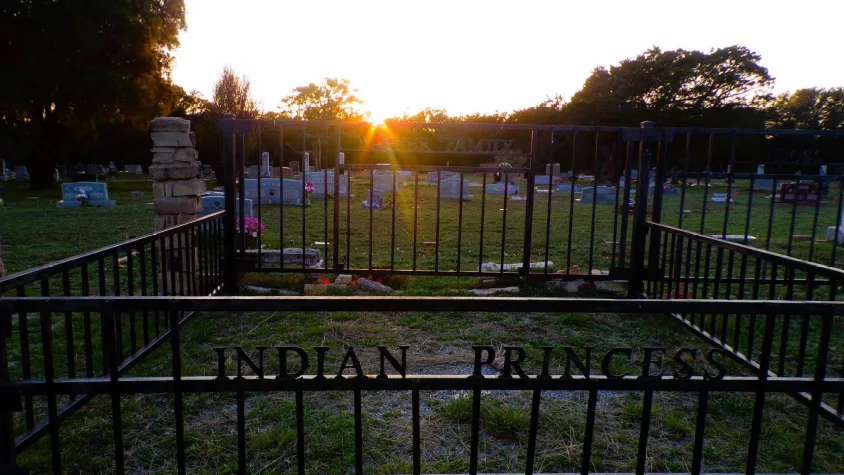
Last week I got a question from a couple who read this column about a grave at Jordan Springs Cemetery, just south of town. The grave is labeled “Indian Princess” in lettering on a wrought iron fence that encloses it. There are no dates or other names. The couple wanted to know if I knew anything about it. I did not, but thought it would be simple enough to find out. Nope.
I ended up spending quite a few hours rearranging search queries, checking cemetery records, calling the courthouse and asking local historians, only to find that discovering who this person was, why she was called an Indian Princess, who labeled the grave as such, when and why, are not easy questions to answer. In fact, I would go so far as to label the whole thing a complete mystery.
According to browncountyhistory.org, Jordan Springs Cemetery is on the same spot where Friendship Baptist Church was once located. The church was established in 1884, and the cemetery was founded in 1887. Jordan Springs was a community in itself for a time, and, according to county historian Clay Riley, the locals pronounced it “Jur-din Springs”. While researching, I discovered several people listed in obituary notices as being from Jordan Springs. Like the Indian Princess, Jordan Springs seems to have disappeared with little trace. There is not much information on Jordan Springs, no historical notes that I could find on when it was founded or by whom.
The land around the church and cemetery was bought by the War Department in 1940 as part of the Camp Bowie project, which probably accounts for a lack of historical records regarding the area. An interesting sidenote on Jordan Springs Cemetery is that a corner of it was used to bury several prisoners of war from Camp Bowie. The remains of the prisoners were returned to their families after the war.
With the government now in charge of the site, Friendship Baptist moved into Brownwood, rebranding as Woodland Heights Baptist Church. According to an article from the Brownwood Bulletin published on March 1, 1963, they brought the old Friendship Baptist building with them into town. The building burned down a few years later, was rebuilt and then burned again. Woodland Heights Baptist merged with another church to form Southside Baptist, which is still in operation today. The chances of any burial records having survived the moves and fires seem slim to none.
The courthouse cemetery records go back to 1890, so it is possible the Jordan Springs Indian Princess grave is older than that. Perhaps this is the reason why there is no record of the name or dates of death and birth for the person buried there. There is a faint trace of brickwork inside the plot that seems to me to be quite old. I’m sure the fence around the plot is newer than the grave itself. So someone knew something about the grave in the not too distant past. Time and money was spent to place the fence and inscription at the site. Was this based on personal knowledge, or simply knowledge of a tale that was passed down generationally?
The couple that contacted me related a story a woman told them about the grave. The story goes that a traveling band of Indians came through town, one of them died and was subsequently buried in the Indian Princess grave. Given the history of warfare between settlers and Comanche, I find it hard to believe a Comanche would be buried in this cemetery. I can’t say it’s impossible, but it seems highly unlikely. I contacted the Cherokee Nation, sending along a picture of the site, to see if they thought it could belong to them. The Cherokee did not have Indian Princesses, nor did any other native tribes, as that type of hierarchy was unknown to them. Still, it’s possible there is some kernel of truth in that story. It is often the way with handed down information that details are changed, yet some parts are nonetheless true.
It seems whoever named the grave in question was probably working off one of these earlier stories, maybe one that was exaggerated or romanticized. The grave is set outside the cemetery proper, meaning the person buried there is not likely to have been a member of the community. Odd as the whole thing seems, the grave is there. It says what it says, and there seems to be no easy explanation for it. Maybe someone out there might know something about this grave, even if it’s just a story that was told to them. Perhaps that could help us piece together the threads to find out more about the Indian Princess of Jordan Springs.
***
Diane Adams is a local journalist whose columns appear Thursdays on BrownwoodNews.com
